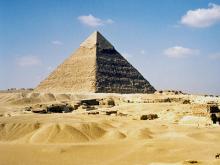
Speak to a specialist
0208 777 4873
0208 777 4873
Giza

.jpg)


he Giza Plateau is the northern extension of the necropolis of Memphis, situated on the west bank of the Nile and is today part of the suburbs of modern Cairo.
The pyramids of Giza have always fascinated mankind and a great many mysteries have been built around them.
The Giza Plateau is famous for three pyramids. Khufu’s son, Khafre (Greek, Chephren) also constructed a pyramid next to his father’s monument. The third pyramid belongs to Menkaure (Greek, Mycerinus) and is the smallest of the three.
Each pyramid had its own associated structures which included satellite pyramids, mortuary temple, causeway and valley temple, though not all of these can be seen clearly today.
The pyramid complexes are surrounded by vast cemeteries of mastaba tombs, similar in size and originally laid out in street-like rows, but these have been disrupted by the intrusion of later burials. Mastaba is the name given to a large rectangular superstructure built over a deep burial shaft and comes from the Arabic word for ‘bench’. There are hundreds of mastaba tombs at Giza where the Old Kingdom elite were buried close to their pharaohs. The earliest and most extensive cemeteries are to the east and west of Khufu’s pyramid. There are also many private tombs cut into the rock-faces of quarries surrounding the pyramids of Khafre and Menkaure. Many of the Old Kingdom tombs at Giza can be visited, but it is difficult to predict exactly which ones are open at any given time. Some of them have spectacular reliefs with beautifully carved hieroglyphs and engaged statues of their owners – the Old Kingdom was possibly the finest period of art in the history of Egypt.
The Giza Plateau’s other claim to fame is for the Great Sphinx, which is situated next to Khafre’s causeway and valley temple. One of the world’s greatest monuments and the first colossal royal statue of ancient Egypt, the Sphinx was known as ‘Abu Hol’ (Father of Terror) to the Arabic people. It is fashioned out of a natural limestone outcrop left over from the quarrying of stone by the builders of the Great Pyramid. The Sphinx is carved in the shape of a crouching lion with a human head, 73m long and over 20m high.
The Giza Plateau is an ongoing excavation site. There are new tombs and structures being discovered with amazing regularity and yet there must be so much still to uncover. Today the whole plateau is a vast tourist complex which could take the visitor weeks to see properly. The area is currently being re-developed to provide even more facilities, with many plans afoot to make the area more ‘tourist friendly’. The new Grand Egyptian Museum will also be built close to the pyramids. There is a Sound and Light Show each evening, presented in Arabic, English, French, Japanese and German, which uses the three pyramids as an impressive backdrop.
The pyramids of Giza have always fascinated mankind and a great many mysteries have been built around them.
The Giza Plateau is famous for three pyramids. Khufu’s son, Khafre (Greek, Chephren) also constructed a pyramid next to his father’s monument. The third pyramid belongs to Menkaure (Greek, Mycerinus) and is the smallest of the three.
Each pyramid had its own associated structures which included satellite pyramids, mortuary temple, causeway and valley temple, though not all of these can be seen clearly today.
The pyramid complexes are surrounded by vast cemeteries of mastaba tombs, similar in size and originally laid out in street-like rows, but these have been disrupted by the intrusion of later burials. Mastaba is the name given to a large rectangular superstructure built over a deep burial shaft and comes from the Arabic word for ‘bench’. There are hundreds of mastaba tombs at Giza where the Old Kingdom elite were buried close to their pharaohs. The earliest and most extensive cemeteries are to the east and west of Khufu’s pyramid. There are also many private tombs cut into the rock-faces of quarries surrounding the pyramids of Khafre and Menkaure. Many of the Old Kingdom tombs at Giza can be visited, but it is difficult to predict exactly which ones are open at any given time. Some of them have spectacular reliefs with beautifully carved hieroglyphs and engaged statues of their owners – the Old Kingdom was possibly the finest period of art in the history of Egypt.
The Giza Plateau’s other claim to fame is for the Great Sphinx, which is situated next to Khafre’s causeway and valley temple. One of the world’s greatest monuments and the first colossal royal statue of ancient Egypt, the Sphinx was known as ‘Abu Hol’ (Father of Terror) to the Arabic people. It is fashioned out of a natural limestone outcrop left over from the quarrying of stone by the builders of the Great Pyramid. The Sphinx is carved in the shape of a crouching lion with a human head, 73m long and over 20m high.
The Giza Plateau is an ongoing excavation site. There are new tombs and structures being discovered with amazing regularity and yet there must be so much still to uncover. Today the whole plateau is a vast tourist complex which could take the visitor weeks to see properly. The area is currently being re-developed to provide even more facilities, with many plans afoot to make the area more ‘tourist friendly’. The new Grand Egyptian Museum will also be built close to the pyramids. There is a Sound and Light Show each evening, presented in Arabic, English, French, Japanese and German, which uses the three pyramids as an impressive backdrop.
Subscribe here to our monthly newsletters


